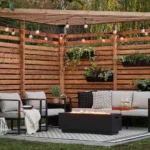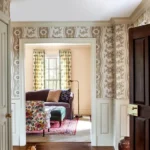Mirrors are powerful tools in interior design, offering a perfect blend of functionality and style. When used effectively, they can transform spaces by amplifying natural light, creating the illusion of larger rooms, and elevating aesthetic appeal.
Whether you’re working with compact areas or spacious interiors, mirrors provide a versatile solution to enhance depth, brightness, and elegance.
From statement pieces to functional accents, the strategic placement and selection of mirrors can redefine the ambiance of any room.
This guide explores practical tips, creative ideas, and expert strategies to help you maximize the potential of mirrors in your home or workspace. Discover how to turn simple reflections into stunning design elements.
Benefits of Using Mirrors in Interior Design
Creates an Illusion of Space
Mirrors reflect light and surroundings, making rooms appear larger than they actually are. This technique is particularly useful for small spaces such as apartments or narrow hallways.
Amplifies Natural and Artificial Light
By placing mirrors opposite windows or light sources, you can enhance the brightness of a room. This creates a warm and inviting ambiance without increasing electricity consumption.
Enhances Aesthetic Appeal
Mirrors come in various styles, shapes, and frames that can complement different interior design themes.
From ornate vintage frames to sleek modern designs, mirrors can serve as statement pieces or subtle enhancements.
Adds Depth and Dimension
Strategically positioned mirrors can create the perception of depth, making even flat, uninspiring walls visually dynamic.
Improves Functionality
Beyond decor, mirrors serve practical purposes, such as aiding in grooming or serving as focal points in entryways to check your appearance before leaving.
How to Use Mirrors Effectively in Interior Spaces?

Positioning Mirrors to Maximize Light
Mirrors placed opposite or adjacent to windows can reflect natural light throughout the room.
For darker spaces, mirrors can reflect artificial light sources such as chandeliers, sconces, or lamps, creating a brighter environment.
Example Placement:
- A large mirror on the wall opposite a south-facing window will maximize sunlight during the day.
- Placing a mirror behind a table lamp can create a cozy, illuminated corner.
Using Mirrors to Expand Small Spaces
In compact areas such as bathrooms, hallways, or tiny bedrooms, mirrors can create an illusion of depth and openness.
Table: Best Mirror Shapes for Small Spaces
| Space Type | Recommended Mirror Shape | Reason |
|---|---|---|
| Narrow Hallway | Long, Rectangular | Extends the visual length. |
| Small Bathroom | Circular | Softens the room’s hard edges. |
| Tiny Bedroom | Oversized Square | Makes the room feel spacious. |
Incorporating Mirrors as Statement Pieces
Large, ornate mirrors can serve as focal points in a room. For example, a gold-framed mirror in a living room can evoke grandeur, while an oversized mirror in a minimalist bedroom adds sophistication.
Design Ideas:
- Antique Mirrors: Use aged or distressed mirrors to complement rustic or vintage interiors.
- Geometric Mirrors: Opt for hexagonal or asymmetrical designs in modern spaces.
- Oversized Leaning Mirrors: Place these against a wall in bedrooms or walk-in closets for a luxurious vibe.
Mirrors in Functional Spaces
Certain rooms benefit from mirrors not just aesthetically but also functionally:
- Bathrooms: Mirrors above sinks are essential. Consider installing LED-backlit mirrors for a contemporary touch.
- Entryways: A mirror near the door adds convenience for last-minute checks and enhances the welcoming feel of the space.
- Living Rooms: Pair a mirror with a console table to create a visually appealing vignette.
Using Mirrors Creatively
Explore unconventional ways to incorporate mirrors into your decor:
- Mirrored Furniture: Coffee tables, cabinets, or side tables with mirrored surfaces reflect light and create a sense of openness.
- Mirror Collages: Combine smaller mirrors of various shapes and sizes to create a gallery wall effect.
- Mirrored Ceilings: Though bold, this technique can dramatically increase the perceived height of a room.
ALSO READ: How to Make Your Bedroom a Cozy Retreat with Minimal Effort?
Mistakes to Avoid When Using Mirrors

While mirrors are powerful design tools, certain mistakes can undermine their effect:
Overusing Mirrors
Too many mirrors can make a space feel disorienting or cluttered. Balance is key.
Placing Mirrors at Awkward Angles
Avoid positioning mirrors where they reflect unattractive views, such as cluttered shelves or ceiling fans.
Ignoring Scale and Proportion
A mirror that’s too small for a wall can look out of place, while one that’s too large can overpower the room.
ALSO READ: How to Maximize Space in Small Apartments with Smart Interior Design
Tips for Selecting the Perfect Mirror
Consider the Room’s Style
Match the frame material and shape of the mirror to the decor style of the room.
Table: Mirror Styles and Corresponding Interior Themes
| Mirror Style | Interior Theme |
|---|---|
| Ornate Gold Frame | Classic, Vintage, French |
| Frameless | Minimalist, Contemporary |
| Wooden Frame | Rustic, Industrial, Bohemian |
| Black Metal Frame | Modern, Scandinavian |
Opt for High-Quality Glass
Ensure the mirror has a high-reflective surface and minimal distortion.
Choose Appropriate Frame Materials
Frames should align with the room’s theme and resist wear, especially in humid spaces like bathrooms.
Advanced Techniques for Mirror Placement

Layering Mirrors with Artwork
Combine mirrors with paintings or photographs for a layered look. For example, a small circular mirror above a rectangular painting can create an artistic focal point.
Creating Symmetry with Mirrors
Symmetrical mirror placement can bring harmony to a space. For instance, placing identical mirrors on either side of a fireplace adds balance.
Using Mirrors to Frame Views
Place mirrors strategically to reflect outdoor landscapes or beautiful indoor elements like chandeliers.
ALSO READ: How to Choose the Perfect Color Palette for Your Living Room?
Conclusion
Mirrors are not just decorative elements; they are transformative tools in interior design.
Whether you aim to brighten a space, create an illusion of size, or add an artistic touch, mirrors offer endless possibilities.
By understanding the principles of mirror placement and style selection, you can elevate your interior spaces to new heights.
Harness the power of mirrors to reflect not just light, but also your unique sense of style and creativity.







